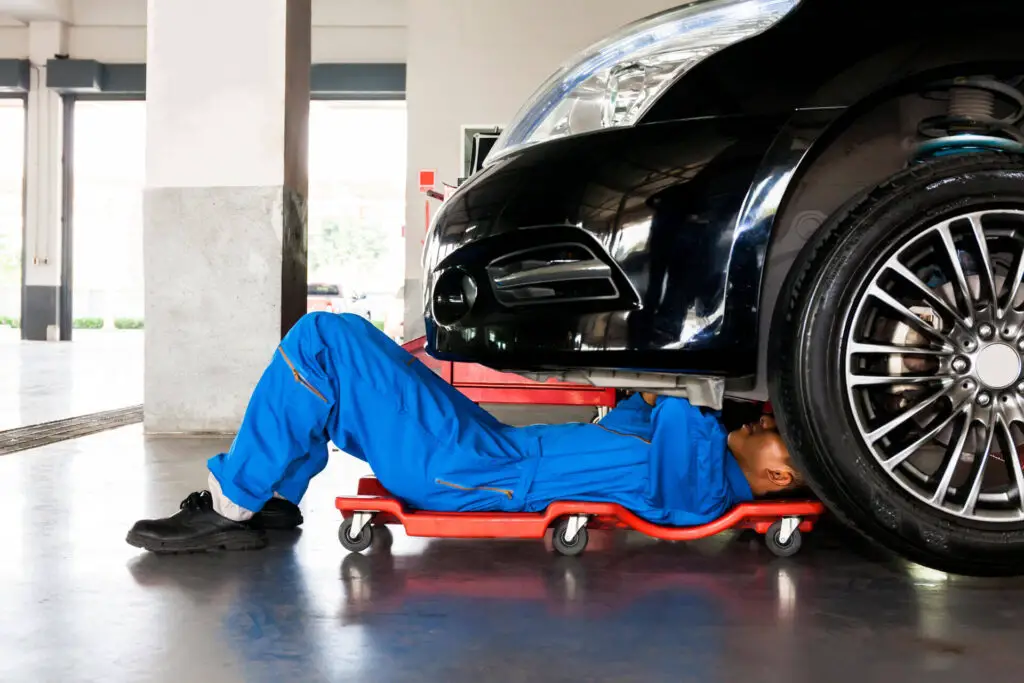The Lamborghinis, Ferraris, and McLarens of the world come with low ride heights. However, a vehicle being low to the ground doesn’t necessarily mean it came from the manufacturer that way. It can be modified, so if you’ve ever wondered how to cut springs to lower a car, here’s everything you need to know.
The only type of coil spring that can actually be cut is the open-end, tangential one. Take the old one out of your car, measure it, and according to that length, cut the new coil spring with a hacksaw or an angle grinder. Once it’s cut, reinstall everything, and the machine is ready for low riding.
What Are Coil Springs and What Are They Used For?
A coil spring is an elastic part made from metal or heavy plastic in the shape of curls or ringlets, like a round of wire wrapped around a cylinder. So, it’s a spiral or a helical-shaped mechanical part that stores potential mechanical energy in order to release it, maintain force, or absorb shock.
Elasticity Is the Main Attribute of a Spring Coil
Coil springs reduce shock and maintain a force between surfaces, and they do it by changing shape when an outside force is applied. Once this external force is removed, spring coils return to their original shape. So, this effective little thing can be very useful and applied to many different things, as you can imagine.
The first spring coil made from steel was produced in 1857 as a part of an armchair. Nowadays, spring coils are used in a lot of everyday objects – clocks, door handles, gates, garage doors, and among other things, your trusted four-wheeler, no matter if it’s a used vehicle or a brand-new one.
The Spring Coils in Your Car Are Made From Hardened Steel
While spring coils are made from elastic materials used for different things, the ones in your four-wheeler are made from hardened steel. The most commonly used materials include chromium-vanadium steel, high and medium carbon steel, chromium silicon steel, and various types of stainless steel, as well as nickel and copper.
While all of them come in the form of a wire, the exact choice of metal depends on where the coil spring will be used. So, let’s take a look at where you can find them in your vehicle and what is their importance in the vehicle’s suspension system.

Coil Springs Are One of the Most Important Parts of a Car’s Suspension System
The suspension system of a vehicle is obviously very important – it ensures safety, as well as a smooth ride, because it has the ability to absorb the energy from various bumps and other kinetic impacts you can encounter on the road. There are a few main parts of a vehicle’s suspension, and spring coils are one of them.
Here are the main mechanical parts that build the car’s suspension system, as well as their purpose:
- Coil springs – help control the height as well as the load of the suspension and cabin,
- Damping components – also known as shocks or dampers, they are hydraulic suspension components that absorb and dampen kinetic energy that the tires transmit,
- Tires – the only part of the suspension system that touches the road,
- Rods or linkages – parts that work together in order to connect different elements of the suspension system,
- Joints, bearings, and bushings – allow suspension system components to slide up and down.
Coil Springs Connect the Unsprung Mass to the Rest of the Vehicle
Wrapped around the damping component, coil springs have a vital role in connecting the unsprung mass, such as the wheels and the brakes, to the sprung mass or, to put it simply, to the rest of the car. This means they work to maintain constant ground clearance – it compresses when a wheel hits a bump and expands if it enters a pothole.

Any Impact on the Road Is Absorbed by Coil Springs and the Rest of the Suspension System
While the construction of the spring coil is fairly simple, they can vary in thickness, density, and number of coils. However, all of them are designed to resist overload and absorb any impact you may encounter on the road. This ensures a smooth ride through the most famous routes in the US, as well as keeps the wheels in contact with the ground at all times. Besides these obviously important aspects, coil springs also make the seats in your vehicle comfortable.
Modern Coil Springs Have Replaced the So-Called Leaf Spring
The coil springs of modern vehicles are a much better alternative to their predecessors – the leaf spring. While this type of spring was characterized by high resistance to the overload, it requires a lot of lubrication, takes up a lot of space, as well as doesn’t guarantee that much of a smooth ride.
These attributes are obviously not fit for modern vehicles, so we have to thank technology and the evolution of cars for overcoming these obstacles. However, with their high resistance to overload, leaf springs are still used on trucks as well as other utility vehicles.

What Kind of Coil Springs Are Used in Modern Vehicles?
So, when it comes to your average city four-wheeler, you are not dealing with leaf springs but with their modern version, and these coil springs come in various different shapes and sizes. This is important to know if you are thinking about cutting them to lower your vehicle because if you can do it or not depends on the type you have.
There are three most common types of coil springs, and they are differentiated by what kind of end they have. The ending is determined by the way springs are mounted in the suspension, and there could be two same or different ends on one coil spring.
Here are the three main types of coil springs depending on their ending:
The Most Common Form Is the Closed-End Coil Springs
The first type of coil spring is the closed-end version, and this is the most common type out there. Here, the end of the coil spring is flat, and its tip is in contact with the adjacent coil. In other words, this is a stable type of coil spring that can stand flat on its own. There is a specific type of closed-end coil springs that have square ends that are grounded. They have much better deflection than open-end springs, as the last coil bends down to touch the one below it.
Open-End Coil Springs Are the Only Type You Can Cut
If you’re interested in cutting your coil springs to lower your vehicle, it’s important to know that the open-end type, sometimes called tangential coil springs, is the only type you can actually do this with. These are continuous springs, meaning the end of the coil twists off into space. They would fall over if they’re left to stand on their own, so they are used in applications where the coil spring will sit on a seat.
Pigtail Coil Springs Are Attached by a Screw or Bolt
The last type of coil spring can be found in cars, but they are primarily used as a part of vibrating conveyors. When it comes to pigtail coil springs, the last coil has a smaller diameter than the rest, and this enables attaching it to a mechanism using a screw or bolt. Same as a closed-end spring coil, it can’t be cut, so if you’re interested in lowering your vehicle, the tangential ends are the only type that can go through this process.
The Most Important Thing to Remember Is That You Can Cut Only Open-End Spring Coils
It’s been mentioned a few times, but I have to underline this because it’s very important – when it comes to cutting coil springs, the only type you can actually do it to is the open-end or tangential ones. That’s because closed-end and pigtail coil springs are designed in order to make full contact with mounting points, and everything would have to be changed if they were cut.
One more essential thing to remember is that you should never use heat because the steel will begin to soften, and there is nothing you can do to get it back into its original shape. When a coil spring is heated, it’s basically ruined, and it will be of no use to you anymore.

The Pros and Cons of Cutting Coil Springs to Lower Your Vehicle
Before we get to the real deal, let’s just outline the pros and cons of cutting coil springs so you can be sure you’re making the right decision. Here’s a brief overview of the pros and cons:
| Aspect | Pros | Cons |
| Performance | Improved aerodynamics, handling, and traction | It may interfere with other components and systems |
| Safety | The risk of a rollover is reduced | Increased risk of the vehicle bottoming out |
| Comfort | It might be more comfortable, but this can be individual | Going over speed bumps won’t be comfortable |
How to Cut Springs to Lower a Car – A Step-By-Step Guide
For any professional mechanic, cutting the coil springs is a standard procedure. But, with a few tools that are easily found in any auto part store, you can do the job yourself. Here’s how to do it, explained step by step:
Raise the Car in Order to Remove the Tire and the Strut
Start by using a jack to raise the area of your vehicle from which you will take out the old coil spring. If you know how to change a flat tire, unscrewing the nuts and removing the tire will be an easy job for you. The next thing you need to do is to remove the strut that holds the coil spring and absorbers, and this should be done by following the owner’s manual because it varies from one model to another.
Measure the Old Coil Spring While It’s Still Compressed in the Strut
After removing the strut, you should use a tape measure and note down the length of the coil spring that is still compressed inside the extended strut. It’s important because it will determine how much of the new coil spring you can cut. Then, remove the old one with a coil compressor because it will allow you to easily remove it and safely decompress the coil spring.
Measure the New Coil Spring and Figure Out How Much You Can Cut
Next, you should measure the distance between the old compressed spring and the other end of the coil spring. Write down that number and add 1 inch (2.5cm), and the measurement you have in front of you is the shortest possible length of the new spring coil. Cut it shorter, and it won’t be of any use to you. So, take that length and mark where you will make a cut with a bright-colored marker.
Cut the Coil Spring and Put Everything Back Together
By using a hacksaw or an angle grinder, as well as the appropriate safety gear, cut the coil spring in the place you marked. Do it very carefully in order to not hurt yourself or cause unnecessary damage to the new coil spring. Once it’s cut, it’s time to do the first step, but in reverse – reinstall the coil spring into the strut and attach the tire back into its place. Once you’ve tightened the lug nuts and put the car back down, you’ve got yourself a lowered vehicle.
Repeat the Process on Each Wheel Before You Start Driving
Of course, the process described above should be done on each wheel, and only once you’ve gotten all of them taken care of, it’s time to hit the road. You should drive it fast in order to get the springs well seated and working properly, but it’s important to stick to your driver’s responsibilities and do it in the safest way possible. If everything seems to work properly, and you’re happy with your car’s height, that means you’ve finished the job successfully.
Now That You Know How to Cut Spring Coils, It’s Time for Some Cool Lowrider Cruising
So, if you follow these instructions, you should be able to enjoy your low ride in no time. Remember, the most important thing is to cut only the open-end, tangential spring coils and also to go through the process safely. Good luck, and I wish you the best time in your new, low-ride dream car!








